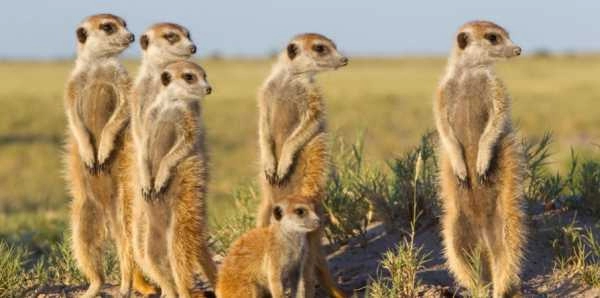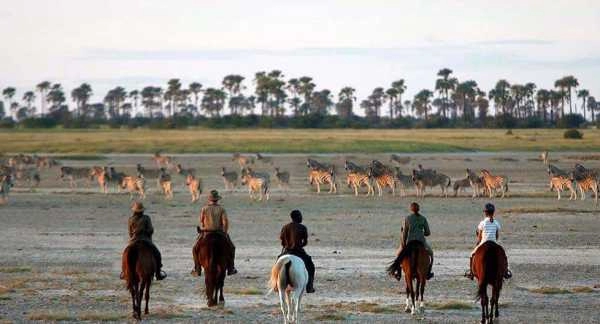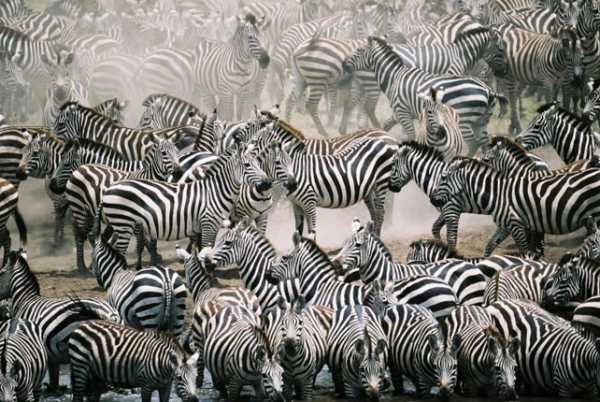Safaris in the dry and wet season are recommended in order to witness the dramatic appearance of the pans at their driest and to experience the transformation after the rains when the wildebeest and zebra migrations occur.

Makgadikgadi and Nxai Pan National Parks in Botswana offer visitors a distinctly different experience even though they are situated close to each other.
One of the world's largest salt pans, The Makgadikgadi Pans cover about 10,000 square km in nothing but salt. Some of the pans are enormous, others the size of small ponds.
Around them are vast grasslands fringed with palm trees. The pans flood after the rains early in the year. Immediately; the desert blooms; attracting thousands of water birds to the shallow pools. The flamingos and pelicans flock to the salty waters and the animals of the plains to the fresh grasses. The flamingos migrate from as far away as East Africa to filter the newly released nourishment and algae from the waters.

The dry season, from April to October, is the desert as you know it with a shimmering whiteness enveloping the scorched landscape, like a mirage floating over the crusted salt, and you’ll spot nomadic herds in the distance, as if an illusion. This is time of year for whizzing across the pans on the back of a quad bike or horse, sleeping under the stars, and enjoying the pans in their most iconic, dazzling state.

When the rains start to fall in November, the Makgadikgadi Pans are transformed. It’s a time of plenty (even in the desert), and the salt flats are turned into watery grasslands, almost unrecognizable from the previous months. A layer of emerald-green grass stretches out in every direction, pink clouds of flamingo and flocks of migratory arrive to nest, and Africa’s second largest mammal migration of wildebeest and our black and white striped friends (Zebra) floods the plains. The green season in the desert is one of Africa’s, great unpredictable spectacles, and a magical time to visit.
Rain transforms everything, turning the pans into lush grasslands from November onwards. Animals are on the move and the desert becomes a green oasis teeming with life, notably thousands of zebra and blue wildebeest that feast on the sweet summer grasses. The safari activities are similar in these months although you usually won’t travel as far; on many days you can see the wildlife direct from your verandah. This green season continues until mid-April and corresponds with the off season for tourism in Botswana, making it a slightly cheaper time to travel.
It is advisable not to drive to Makgadikgadi in the rainy season due to the roads being inaccessible but the spectacle is great to see from the air so book a flight into this area.
The Nxai Pan was once part of the great lake that covered central Botswana, but now they are mostly fossil pans, covered with good grasslands rather than salt.
Perhaps the focal point of Nxai Pan is the water hole, situated only two kilometres from the entrance gate, in the midst of a large grassy plain which is dotted with a few clumps of short umbrella thorn trees. Here, and within the mopane woodland, lion, giraffe, kudu, impala, ostrich, fascinating birdlife and large numbers of springbok, together with a good population of jackal, bat-eared fox and numerous smaller creatures, are permanent residents. Once the rains have started, gemsbok, elephant and zebra migrate to the area. At that time, zebra are present in thousands and drop their young at Nxai Pan, rivaling the spectacle of the multitude of young springbok, to further enhance game-viewing opportunities.
Perhaps the focal point of Nxai Pan is the water hole, situated only two kilometres from the entrance gate, in the midst of a large grassy plain which is dotted with a few clumps of short umbrella thorn trees. Here, and within the mopane woodland, lion, giraffe, kudu, impala, ostrich, fascinating birdlife and large numbers of springbok, together with a good population of jackal, bat-eared fox and numerous smaller creatures, are permanent residents. Once the rains have started, gemsbok, elephant and zebra migrate to the area. At that time, zebra are present in thousands and drop their young at Nxai Pan, rivaling the spectacle of the multitude of young springbok, to further enhance game-viewing opportunities.
Whilst most game reserves are not considered to be at their best during the rains, Nxai Pan becomes a veritable Garden of Eden. This area offers the most incredible safari experience. There is an abundance of game and bird life.
Zebra Migration:
In the rainy, summer months, around November to April, thousands upon thousands of zebra invade Nxai Pan National Park from the northern Chobe banks, to take full advantage of the rich pastures, rain-ripe grasslands, and brimming waterholes. Their striped presence delights fanged predators, such as lion, cheetah and leopard, who feast upon them in droves. It is the second largest land animal migration in Southern Africa.
More recently, after fences were dropped, a 'new' Zebra migration has started from Okavango Delta to Makgadikgadi although on a slightly smaller scale.

A variety of accommodation is offered from luxury safari tented camps to a traditional type of camp.
Email us to book your This email address is being protected from spambots. You need JavaScript enabled to view it. now.
